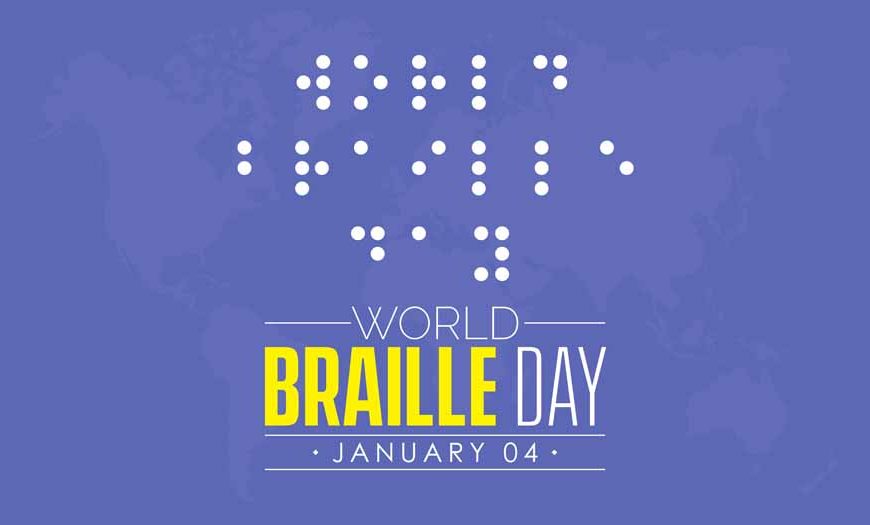World Braille Day is celebrated to honour Louis Braille and his pathbreaking contribution to the world. His brilliant work of creating braille as a means of communication for visually impaired people changed their lives forever. Born in France, Louis Braille lost his sight at the young age of 14 when he accidentally poked his eye with a stitching awl. His injured eye got infected and spread to his other eye which caused Louis to lose his sight. He developed the fingertip reading system known as braille after Charles Barbier visited his School for the Blind. Charles Barbier shared a communication code called Night Writing with the students and when Louis was 15 years old he invented the new communication system of fingertip reading that revolutionised the lives of the visually impaired.
When is World Braille Day Celebrated
Louis Braille was born in France on January 4, 1809, and World Braille Day celebrates his 210th birthday to honour his invention of the Braille system of reading and writing which revolutionised the lives of the visually impaired. World Braille Day was declared as an international day in late 2018 by the United Nations General Assembly. The first celebration of this day was on January 4, 2019 but many people celebrated World Braille Day even before the United Nations recognised it. The invention of braille drastically enhanced the human rights of blind people as it allowed them to remain independent. They don’t have to depend on sighted people to interpret any text for them and can keep their personal information like healthcare forms and bank statements confidential.
Interesting Facts About Braille
- In January 2016, members of the Braille Authority of North America voted for Unified English Braille to replace the former system. This resulted in all English speaking countries using the same version of braille. Earlier, the United States’ version of braille was different from the one used in Great Britain. Unified English Braille has extra characters to let readers know where the capitalisation, bold and underlining goes.
- Six dots make up a cell in braille and there are 64 braille cell combinations along with an empty cell. Braille cells are approximately the size of 29pt Arial font which means it takes up nearly three times more pages than standard print. Also, double sided braille copies are both difficult and expensive to make. As a result, braille books are much bigger and heavier than traditional print materials. For example, a braille copy of a Harry Potter book would go up to 13 volumes with each weighing 9 pounds.
- Braille used for maths differs from braille used for writing the alphabet. Nemeth is one system for writing maths in braille. Sheet music also has a different version of braille where the dots represent parts of music instead of letters. Though braille music uses the traditional 6 dot cell, it has its own syntax and translations.
- The World Braille Union along with the World Intellectual Property Organization created the Marrakesh Treaty in 2013 to remove barriers that were inhibiting the transcribing of intellectual property into braille.
- Though many think of braille as a language or as something similar to sign language, it’s more of a code. Each braille cell has 6 raised dots and different combinations of these dots are used to show letters, numbers, punctuation etc. Almost all languages can be converted into Braille and it is used throughout the world.
- There is more than one type of braille. Uncontracted or grade 1 braille converts each printed character into a braille cell. All 26 letters and symbols are accounted for and there are no abbreviations or contractions. Contracted or grade 2 braille uses contractions and abbreviations to save time and space and time when reading. Common letter combinations and common words such as ‘and’, ‘or’ and ‘can’ are contracted. Grade 2 braille is used in many books and magazines. are printed with contracted Braille. Some writers use grade 3 or shorthand braille for notes and personal letters.
- Not every visually impaired person reads braille and this is largely due to the latest advances in screen reader technology and portable devices. There are other factors too as some people have reduced sensitivity in their hands which makes it difficult for them to press down hard enough to identify the dots.
- Braille is available on drive-up ATMs where the driver uses the Braille buttons for transactions. This allows them to use the ATM independently without their privacy being compromised. The additional raised print numbers are also beneficial for people with poor vision or people who may not be wearing their reading glasses.
- Some people learn Braille and print as they may be suffering from low vision or degenerative vision conditions at a young age. As a result, they learn to read both Braille and print and are often referred to as dual media users. This ensures that they develop important literacy skills and retain their ability to read as their vision deteriorates. Many accessibility libraries are stocked with material available in braille and large print to support dual media users and provide physical or digital copies of books in accessible formats for readers who need them.
- It is possible to type using a Braille keyboard on your iOS device. The Braille or Perkins keyboard has 3 keys on the left side, a large space key in the centre and 3 keys on the right side. By using the keys in a certain sequence, people can easily type messages in Braille. To enable this on your iOS device you need to go to ‘VoiceOver’ screen reader settings and enable ‘Braille screen input’.
The reading and writing system created by Louis Braille is used by millions of blind and partially sighted people and completely changed their lives. It has opened a whole new world to the visually impaired and to commemorate this invention NASA named an asteroid called 9969 Braille after him in 1992. Braille is a helpful and inclusive tool and we hope these interesting facts about World Braille Day will help you develop more appreciation for how this system came to being the next time you come across it. The tactile reading and writing system of braille gives millions of people around the world the opportunity for literacy. The legacy of Louis Braille can be kept alive by celebrating this day and ensuring that more and more people learn braille. Braille grants them access to information independently and without being dependent on anyone. The best way to honour Louis Braille and celebrate World Braille Day is to incorporate Braille into your life wherever you can and spread awareness about it. For more interesting facts about World Braille Day and the impact that it has had on millions of lives, do touch base with the EuroKids website for the latest updates.















